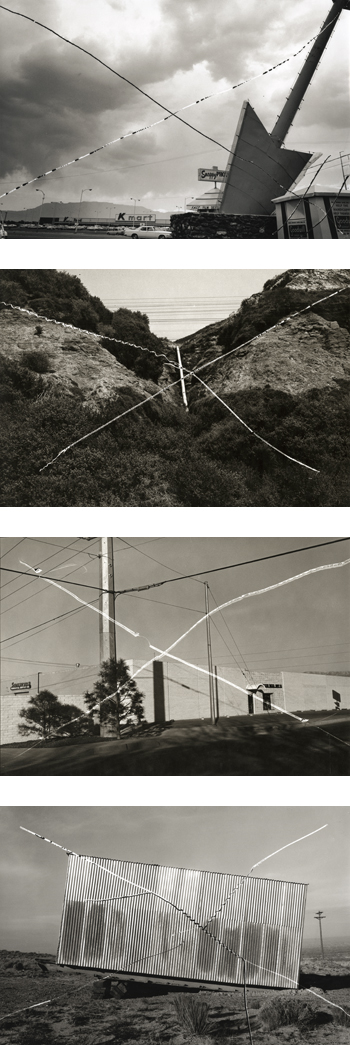
Thomas Barrow: 'Cancellations'
by Aaron Schuman
Summer 2012
This essay was originally published in Aperture #208, Fall 2012.
For reasons that aren't really worth expanding upon here, during a recent trip to Houston, I found myself trudging through a barren and forbidding landscape, in search of a waffle iron. Without a car of my own, I had taken public transportation as far as it pitifully stretched, and with only an address in hand I struck out into a wasteland of strip-malls and parking lots, aiming quite literally for a Target. A storm was brewing; tornadoes had been reported west of the city; intermittent but nevertheless torrential showers—along with the speeding cars that followed in their wake—had transformed any semblance of a sidewalk into deep, elongated puddles. My feet were soaked, my Target was farther than expected, my quest felt increasingly futile, and a passage from of Garry Winogrand's 1963 Guggenheim application essay (which I often quote to my students) seeped into my head:
Since WWII we [Americans] have seen the spread of affluence, the move to the suburbs and the spreading of them, the massive shopping centers to serve them, cars for to and from [ . . . I] feel that who we are and what we feel and what is to become of us just doesn't matter. Our aspirations and successes have been cheap and petty [ . . . ] I can only conclude that we have lost ourselves, and that the bomb may finish the job permanently, and it just doesn't matter, we have not loved life.
Simultaneously, I thought of Thomas Barrow's Cancellations—a series that, coincidentally, I'd first encountered during a trip to the Museum of Fine Arts, Houston, several years earlier. In the 1970s and '80s Barrow photographed strip-malls, shopping centers, apartment blocks, industrial parks, desert ranches, commercial warehouses, highways, byways, and more throughout the American West. He then carved Xs through his negatives, printed them beautifully, and applied a seductive sepia tone to resulting works.
Barrow's Cancellations certainly have some common ground (mostly in terms of subject matter) with the works of many of his contemporaries—particularly those featured in the 1975 exhibition New Topographics: Photographs of a Man-Altered Landscape. But rather than adopting the objectivizing "anthropological viewpoint" cited by New Topographics curator William Jenkins, Barrow's compositional style and subsequent attacks on his negatives reveal a profound disappointment and disgust with what he encountered. It is as if Barrow were desperate to avert his gaze from these sights and experiences, or at least to destroy the evidence that might remain.
For instance, in DART (1974), Barrow seemingly swings his camera to the left and tilts it awkwardly skyward, destabilizing the frame rather than imposing order, rigor, or structure (as New Topographics artists Lewis Baltz, the Bechers, Frank Gohlke, or Stephen Shore might have done). Dark, looming clouds take center stage, and a colossal arrow appears to have plunged from them into the right third of the scene, crashing into a parking lot shared by Snappy Photos, a Goodwill, and a K-Mart that obscures a distant mountain range. Furthermore, Barrow's brutal scratches crisscross the frame, as if the entire experience had been vengefully keyed, with two additional slashes across the Goodwill for good measure.
These photographs seethe with anger and a sense of refusal; they distill both the scene and Barrow's response to it, and resolve the resulting image, negative, and print into one physical "thing"—the photograph—imbuing it with deep meaning and powerful, visceral emotion.
In his 1985 essay "Too Old to Rock, Too Young to Die," Baltz addressed what he described as the "mixed-media photography" trend of the 1970s, stating:
It was genuinely an attempt to take photography beyond the physical limitations of the unaltered photographic print and enhance it with the plasticity, object-hood, and visual surface of the other graphic arts. This work failed to gain wide acceptance outside the academic world [ . . . ] the complexity of facture usually took precedent over the nominal content of the work.
In 1984 Barrow wrote in a letter to a friend: "I want to alter the photographic surface—that is, move from the transparent, window-on-the-world form that has been photography's primary reason for being since its invention, to making it a physical object, an object to be looked at for its own presence and not for a surrogate experience."
Yet, tramping through the rain, over crumbling curbs and across the vast asphalt landscape of Houston's commercial hinterlands, I recalled the violence of Barrow's Cancellations, the scars the images bear, and his brave, brazen acts of both formal and conceptual negation. When faced with an American landscape that was practically indistinguishable from those in his images—one that inspired little more than the bleak ache of disillusion—I realized that the content of Barrow's work is in no way nominal. Indeed, it is precisely through the interplay of content and surface, of image and physical object, that Barrow's series serves not so much as a surrogate for, but instead as the embodiment of experience. The object was present, and at the same time the present was entirely embedded in the object.
Thomas Barrow's Cancellations will be released by powerhouse Books in October 2012.
All images courtesy of Joseph Bellows Gallery.
Aaron
Schuman Photography
Copyright © Aaron Schuman, 2012. All
Rights Reserved.
This site and all of its contents may not be reproduced, in whole or in
part, in any form, without the written permission
of Aaron Schuman, and other additional artists involved in the production
of specific works exhibited on this site.